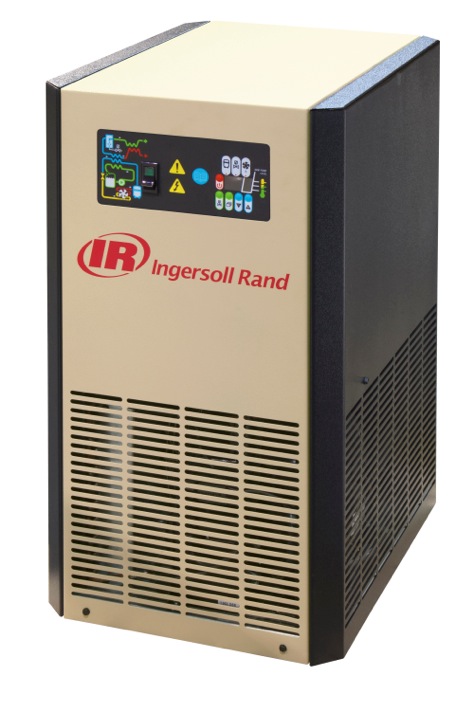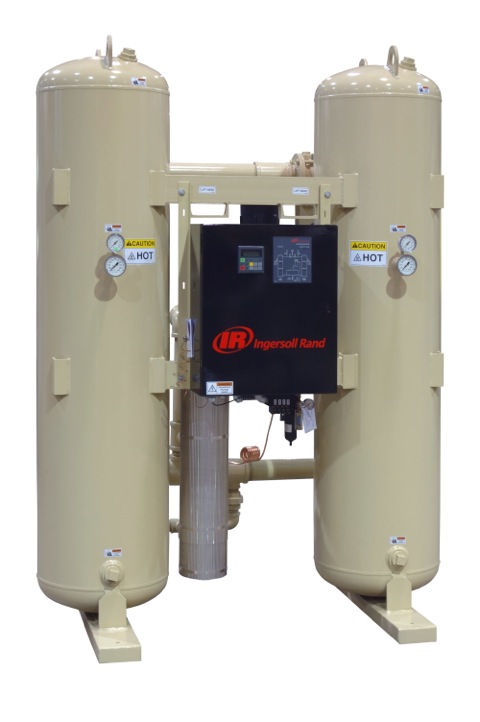Every facility has differing application needs and usage demands, but selecting the right compressed air dryer for the situation will have a significant impact on energy savings and efficiencies.
Compressed air systems account for a significant portion of a facility’s overall operating costs. Choosing the right type of compressed air dryer for the application, and making sure that dryer is using energy in proportion to the demand when possible, can yield major savings over the life of the system.
Two categories of air dryers — refrigerated dryers and desiccant dryers — are widely used in industrial applications, and both have a place in the market. There isn’t a one-size-fits-all dryer solution for every facility. However, looking at the energy costs associated with the various options can help determine which solution will be most beneficial.
Refrigerated Dryers
|
|
Typically, refrigerated dryers are the most economical to purchase and maintain, and they work well for most general manufacturing applications. These dryers yield air with a pressure dew point between 38 and 50 degrees F.
Refrigerated dryers reduce the temperature of compressed air through contact with a cold medium. Since cold air cannot hold as much moisture as hot air, saturated air condenses out moisture as the air temperature decreases, drying the air. The resultant moisture is removed using a moisture separator within the dryer and eliminated from the dryer through the drain system.
Refrigerated dryers generally fall into two categories: non-cycling and cycling, both of which use a refrigeration system to cool the compressed air. The two technologies differ in that once a non-cycling dryer is powered on, the refrigeration system runs continuously regardless of demand, while a cycling dryer can store cold energy within the unit until it is needed, which offers the ability to use energy in proportion to the demand. Most non-cycling dryers include a hot gas bypass valve to keep the dryer from freezing.
Because cycling dryers can store cold energy until it is needed, they help facilities conserve energy. Cycling dryers use the refrigeration system to cool a glycol-water mixture. This thermal mass exchanges heat with the warm air coming into the system, thereby cooling the air and warming the thermal mass. Once the thermal mass temperature rises above a set point, the refrigeration system is activated. The refrigeration system drives down the temperature of the thermal mass until it reaches the desired low temperature, at which point the refrigeration system turns off. This type of operation uses only the energy required to address the incoming air load on the dryer, another boost to energy efficiency.
Different air drying technologies yield different energy costs. The electrical costs for refrigerated dryers are essentially the refrigeration compressor, the controls and, in the case of an air-cooled unit, the condenser fans. Some units might have other components, such as a thermal mass pump, that make a minor contribution to the overall energy consumption.
Non-cycling refrigerated dryers are the least expensive models to purchase. However, cycling dryers provide the ability to use energy in proportion to demand, so they may ultimately be the least costly to own over the life of the dryer.
Desiccant Dryers
|
Instead of relying upon a refrigeration system that cools the air, desiccant dryers use porous desiccant beads to adsorb moisture from untreated air. Desiccant dryers, which provide air with a pressure dew point ranging from -40 to -100 degrees F, use two towers, each filled with desiccant material. While one tower adsorbs the moisture and dries the air, the second tower is regenerated. By alternating tower functions, desiccant dryers provide a constant stream of very dry air.
Desiccant dryers are good for applications where outdoor compressed air piping is subject to freezing. Critical applications, such as pharmaceutical and food applications, require the particularly dry air that is beyond what a refrigerated dryer is able to provide. There are three types of desiccant dryers used widely in the market: heatless, heated and blower purge. Energy costs vary by the type of desiccant dryer, with the energy use tied mostly to the manner of regeneration of the desiccant material.
Generating compressed air is an expensive process, and heatless dryers use about 15 percent of the compressed air emerging from the dryer to remove moisture from the desiccant beads, in order to regenerate it. This means that even though heatless desiccant dryers are less elaborate and often have no added electrical components other than the controls on the dryer, they can actually be higher consumers of energy compared to the other desiccant technologies because the cost of diverting 15 percent of the compressed air must be factored into overall energy costs.
Heated desiccant dryers incorporate a heater in the regeneration circuit of the dryer. This type uses a combination of heat and airflow to regenerate the desiccant adsorption beads in the regenerating tower. So while heated dryers consume additional energy with the supplementary heater, they use about half the compressed air for regeneration than that of heatless dryers. Therefore, heated dryers often are less costly to operate than heatless desiccant dryers.
The third type of desiccant dryer, blower purged units, do not use compressed air to regenerate the desiccant. Instead, this model has a dedicated blower to draw air from the surrounding environment. Because the airflow is generated by the blower, the total air capacity of the air compressor is available at the dryer outlet. This means the expense of compressed air for regeneration is not a factor, but there is the added energy use from the electric motor used to drive the blower.
The bottom line with desiccant dryers regarding energy consumption: Dryers that rely on large quantities of compressed air for regeneration probably will be more expensive to operate than dryers requiring less compressed air. Of the different desiccant designs, the blower purge type has the greatest up-front cost but is often the most efficient to operate because it does not use expensive compressed air for regeneration.
Many manufacturers do make desiccant dryers with technology that can regulate the switching and the compressed air consumption based on the demands on the dryer, which helps to make them more energy efficient. Such energy management systems typically either sense if the moisture front in the tower has reached a certain level, or they measure the actual output dew point of the dryer. This technology can prolong the switch-over of the towers, so the dryer’s regeneration cycle is not starting on a fixed increment of time but instead being initiated based on demand. Alternatively, the energy management systems may hold the purge valves closed, preventing purge air from being used until it is needed for regeneration.

Reliability Issues
While energy use accounts for a significant portion of a compressed air system’s operating costs, reliability also should be factored in when considering the total cost of ownership.
Refrigerated dryers use hermetic refrigeration systems, meaning the refrigerant is not exposed to the atmosphere, so they typically require low maintenance and service to keep the system running.
Desiccant dryers involve frequent valve-switching to direct air to either the drying or regeneration tower, and these models often operate in high-heat, high-demand applications. Therefore, this equipment requires more service and valve maintenance. Downtime for that maintenance should be factored into the overall life cycle cost of the product.
User Needs
First and foremost, user needs should dictate the choice of dryer technology. Refrigerated dryers have substantially lower up-front and energy operating costs than desiccant dryers, but they are not able to provide air that is as dry. For general manufacturing processes, the refrigerated dryer option probably will be sufficient. Desiccant dryers provide the driest air for critical applications, but have higher up-front and energy costs.
In making the selection, users should consider if the pipe work associated with the process is located in a conditioned or unconditioned space. Desiccant dryers are the best choice if the piping is exposed to harsh conditions, such as temperatures that are below 40 degrees F.
If a downstream process machine requires that the air be drier than what a typical refrigerated dryer can deliver, point-of-use equipment may be the right answer. Such a system may use refrigerated dryers for most of the applications and desiccant models only where they are needed for specific applications.
Consider System Optimization
While energy savings can be achieved by selecting the proper dryer for specific applications, system optimization should also be considered for all air systems to maximize efficiency and minimize operating costs.
Dryers are one part of a full compressed air system, and inefficiency of the system as a whole can have as much impact on energy costs as the dryers themselves. Fixing and repairing piping and valve leaks, maximizing air use within a facility and maintaining all compressed air equipment can help recoup the up-front dryer costs by ensuring the system as a whole is operating more efficiently.
The value of a compressed air audit and consideration of the system as a whole to determine true energy costs should not be overlooked. Compressed air system optimization is key for organizations looking to reduce energy costs.
Visit www.irco.com.
About the Author
Christopher Ursillo is the product manager for air treatment products at Ingersoll Rand. He has a degree in mechanical engineering from Villanova University and diverse professional experience in engineered systems and product development. Ursillo has worked in the compressed air industry for 14 years with a focus on air treatment. His responsibilities have spanned from application engineering to managing air treatment marketing programs. He has authored several articles weighing compressed air treatment options and the practical application of each technology. For questions or comments for Ursillo, contact External Communications Leader Anne Wages.
To read more Air Treatment Technology articles, visit www.airbestpractices.com/technology/air-treatment.


 Desiccant dryers, which provide air with a pressure dew point ranging from -40 to -100 degrees F, use two towers, each filled with desiccant material. While one tower adsorbs the moisture and dries the air, the second tower is regenerated. By alternating tower functions, desiccant dryers provide a constant stream of very dry air.
Desiccant dryers, which provide air with a pressure dew point ranging from -40 to -100 degrees F, use two towers, each filled with desiccant material. While one tower adsorbs the moisture and dries the air, the second tower is regenerated. By alternating tower functions, desiccant dryers provide a constant stream of very dry air.


